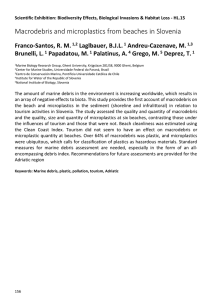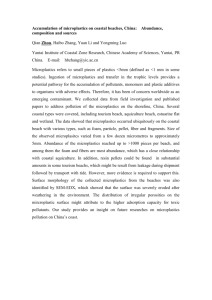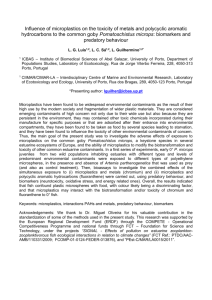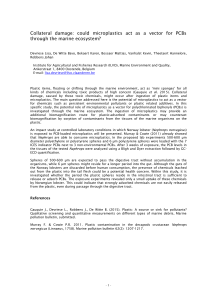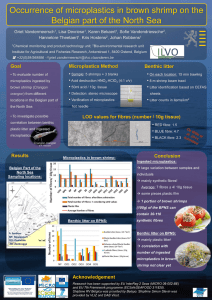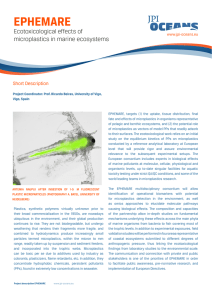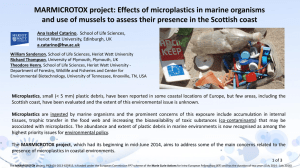PLASTOX Direct and indirect ecotoxicological impacts of microplastics on marine organisms
advertisement
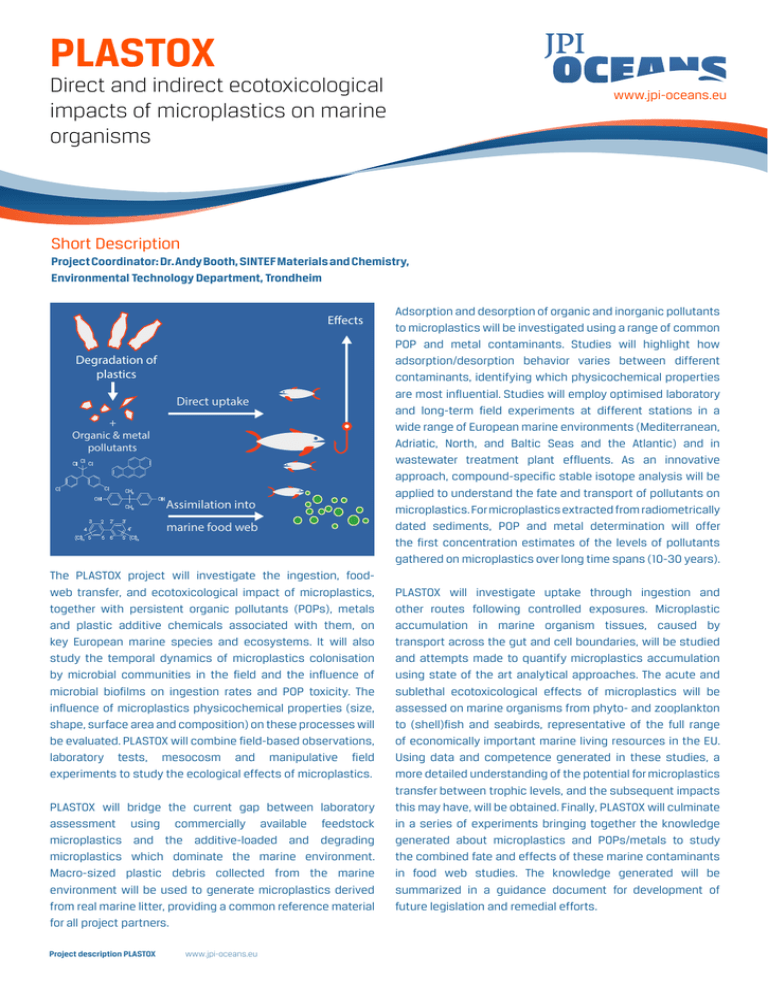
PLASTOX Direct and indirect ecotoxicological impacts of microplastics on marine organisms www.jpi-oceans.eu Short Description Project Coordinator: Dr. Andy Booth, SINTEF Materials and Chemistry, Environmental Technology Department, Trondheim Effects Degradation of plastics Direct uptake + Organic & metal pollutants Assimilation into marine food web The PLASTOX project will investigate the ingestion, foodweb transfer, and ecotoxicological impact of microplastics, together with persistent organic pollutants (POPs), metals and plastic additive chemicals associated with them, on key European marine species and ecosystems. It will also study the temporal dynamics of microplastics colonisation by microbial communities in the field and the influence of microbial biofilms on ingestion rates and POP toxicity. The influence of microplastics physicochemical properties (size, shape, surface area and composition) on these processes will be evaluated. PLASTOX will combine field-based observations, laboratory tests, mesocosm and manipulative field experiments to study the ecological effects of microplastics. PLASTOX will bridge the current gap between laboratory assessment using commercially available feedstock microplastics and the additive-loaded and degrading microplastics which dominate the marine environment. Macro-sized plastic debris collected from the marine environment will be used to generate microplastics derived from real marine litter, providing a common reference material for all project partners. Project description PLASTOX www.jpi-oceans.eu Adsorption and desorption of organic and inorganic pollutants to microplastics will be investigated using a range of common POP and metal contaminants. Studies will highlight how adsorption/desorption behavior varies between different contaminants, identifying which physicochemical properties are most influential. Studies will employ optimised laboratory and long-term field experiments at different stations in a wide range of European marine environments (Mediterranean, Adriatic, North, and Baltic Seas and the Atlantic) and in wastewater treatment plant effluents. As an innovative approach, compound-specific stable isotope analysis will be applied to understand the fate and transport of pollutants on microplastics. For microplastics extracted from radiometrically dated sediments, POP and metal determination will offer the first concentration estimates of the levels of pollutants gathered on microplastics over long time spans (10-30 years). PLASTOX will investigate uptake through ingestion and other routes following controlled exposures. Microplastic accumulation in marine organism tissues, caused by transport across the gut and cell boundaries, will be studied and attempts made to quantify microplastics accumulation using state of the art analytical approaches. The acute and sublethal ecotoxicological effects of microplastics will be assessed on marine organisms from phyto- and zooplankton to (shell)fish and seabirds, representative of the full range of economically important marine living resources in the EU. Using data and competence generated in these studies, a more detailed understanding of the potential for microplastics transfer between trophic levels, and the subsequent impacts this may have, will be obtained. Finally, PLASTOX will culminate in a series of experiments bringing together the knowledge generated about microplastics and POPs/metals to study the combined fate and effects of these marine contaminants in food web studies. The knowledge generated will be summarized in a guidance document for development of future legislation and remedial efforts. Consortium Organisation Name Country Dr. Andy Booth SINTEF Materials and Chemistry, Environmental Technology Department, Trondheim Norway Dr. Kaori Sakaguchi-Söder Technische Universität Darmstadt, Darmstadt Germany Dr. Richard Sempere AIX-MARSEILLE UNIVERSITE-M.I.O. (Mediterranean Institute of Oceanography), Marseille France Dr. Jan Andries van Franeker IMARES Wageningen UR (Institute for Marine Resources and Ecosystem Studies), Den Helder The Netherlands Dr. Kerstin Magnusson IVL Swedish Environmental Research Institute, Göteborg Sweden Prof. Laura Airoldi Alma Mater Studiorum - University of Bologna Italy Prof. Geir Gabrielsen The Norwegian Polar Institute, Tromsø Norway Prof. Paula Sobral NOVA.ID FCT, Caparica Portugal Dr. Thomas Doyle National University of Ireland Galway, Galway Ireland Dr lurgi Salaverria Norwegian University of Science and Technology (NTNU) Trondheim Norway Dr. Dorte Herzke Norwegian Institute of Air Research (NILU), Tromso Norway Dr. Carl van Colen Ghent University, Ghent Belgium Dr. Amaia Orbea Universidad del País Vasco/Euskal Herriko Unibertsitatea (UPV/EHU), Basque Country Spain Prof. Tamara Galloway University of Exeter, Exeter United Kingdom Dr. Hartmut Nies BSH / Federal Maritime and Hydrographic Agency, Hamburg Germany Associated partners Project description PLASTOX www.jpi-oceans.eu
